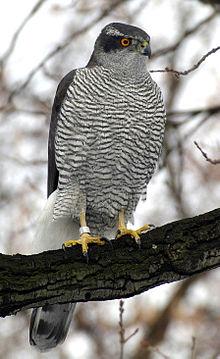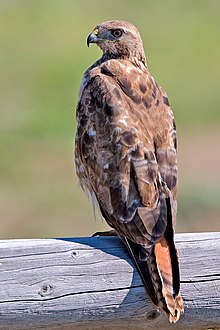| Hawk | |
|---|---|

| |
| Adult Eurasian goshawk | |
| Scientific classification | |
| Domain: | Eukaryota |
| Kingdom: | Animalia |
| Phylum: | Chordata |
| Class: | Aves |
| Order: | Accipitriformes |
| Family: | Accipitridae |

Hawks are birds of prey of the family Accipitridae. They are very widely distributed and are found on all continents except Antarctica.[1]
The subfamily Accipitrinae includes goshawks, sparrowhawks, sharp-shinned hawks, and others. This subfamily are mainly woodland birds with short broad wings, long tails, and high visual acuity. They hunt by dashing suddenly from a concealed perch.[2]
In America, members of the Buteo group are also called hawks, though birds of this group are called buzzards in other parts of the world. Generally, buteos have broad wings and sturdy builds. They are relatively larger-winged and shorter-tailed than accipiters, and fly further distances in open areas. Buteos descend or pounce on their prey rather than engaging in fast, horizontal pursuit.
The terms accipitrine hawk and buteonine hawk are used to distinguish between the types in regions where hawk applies to both. The term "true hawk" is sometimes used for the accipitrine hawks in regions where buzzard is preferred for the buteonine hawks.
All these groups are members of the family Accipitridae, which includes hawks and buzzards as well as kites, harriers, and eagles. To confuse things further, some authors use "hawk" generally for any small to medium Accipitrid that is not an eagle.[3]

The common names of some birds include the term "hawk", reflecting traditional usage rather than taxonomy. For example, some people may call an osprey a "fish hawk" or a peregrine falcon a "duck hawk".
- ^ "hawk | Types, Diet, & Facts | Britannica". www.britannica.com. Retrieved 2022-07-25.
- ^ Campbell, B., Lack.E (2013) A Dictionary of Birds. p.273
- ^ Debus, Stephen J. S. (1990). The birds of prey of Australia: a field guide. Melbourne: Oxford University Press. pp. 12, 16, 62. ISBN 0-19-550624-3. Debus writes that the osprey is "a large aquatic hawk, with adaptations for catching fish by plunge-diving into water"; the elanid kites are "small, gull-like, grey-and-white hawks with black forewing patches"; and, of the harriers, that the "hawks in this cosmopolitan genus ('circling hawk') are so-called because of their low harrying flight". But he refers to the "typical or milvine kites" as "large kites", not hawks.